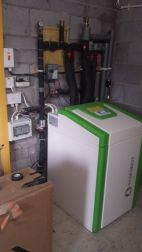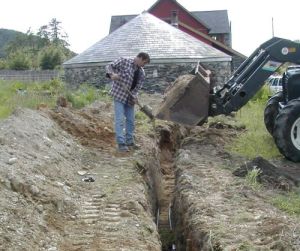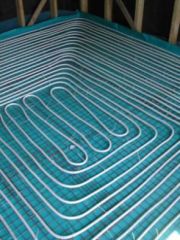Ground Source heat pumps (GSHPs) extract heat stored in the ground, and promise to deliver good year-round energy-efficiency, and can offer considerable long-term environmental advantages. ‘Ground source’ was occasionally referred to as ‘geothermal’. However, the heat is mostly from the surface (solar gain), and very little is from the earth’s core. (‘Proper’ geothermal is found in several parts of the world, including Iceland, Japan, New Zealand and even Southampton).
At depths of 2m and more, the ground temperature does not deviate very much from the average summer/winter surface temperatures (around 8° to 12°C [46ºF to 54ºF] in the UK depending on location). At this depth, there is an enormous store of heat that can be usefully tapped for heating in the winter.
The most practical way of extracting this energy is to bury a large amount of pipe in the ground. This is usually laid in horizontal trenches at depths between 1.2 and 1.5m depth. If insufficient land area is available, or if excavating a garden is impractical, then vertical boreholes are an alternative method, giving similar results. However, the borehole method is usually considerably more expensive to install.
Basic description of the component parts of a GSHP:

1. A heat pump packaged unit
The water-water or glycol-water type shown (approx. the size of a fridge) has source-water/glycol pipe connections and heated-water pipe connections. Sometimes the unit contains a domestic hot water cylinder (DHW), in which case the unit will be the size of a large fridge freezer.
 2. The heat source
2. The heat source
This is usually a closed-loop of plastic pipe containing a Glycol Antifreeze solution. Pipes are buried in the ground in the form of vertical bore holes or horizontal trenches. The trenches take either straight pipe or coiled pipe buried around 1.5m below the surface. A large area is needed for this, so it won’t be practical for many situations.
The picture shows one of several horizontal trenches being back-filled after the pipes have been laid.
 3. The heat distribution system, or Heat Emitter system.
3. The heat distribution system, or Heat Emitter system.
This is either underfloor heating pipes or conventional panel radiators with a large surface area, connected via normal water pipes. Fan-assisted radiators are also an option here. Any ’emitter’ system must be compatible with the low temperure requirements of heat pumps.
Air source systems have the same heat-emitter requirements as ground source.
4. Electrical input and controls.
The system will require an electrical input, and the electric distribution operator DNO should be notified to verify that the building’s mains supply is adequate.
A specialised controller will be incorporated in the heat pump to provide temperature and timing functions of the system. A good controller can be key to a energy-efficient system. As time goes on, controllers get better and easier to use.
Ground Source Heat Pumps offer several advantages
- The water-water (or Glycol antifreeze-water) heat pump unit is a sealed & reliable self-contained unit that should last a long time.
- The refrigerant is factory-charged and very unlikely to leak at all.
- There are no corrosion or degradation issues with buried plastic pipes, and the heat pump unit is indoors in the warm and away from damp.
- The system will continue to provide good output even during extremely cold spells.
- The installation is fairly invisible. i.e. no oil tanks or outside unit to see.
- Very little regular maintenance required.
Ground source heat pump disadvantages
- A lot of disruption is caused during the ground installation process.
- Sufficient land is not always available.
- The installation can be costly.